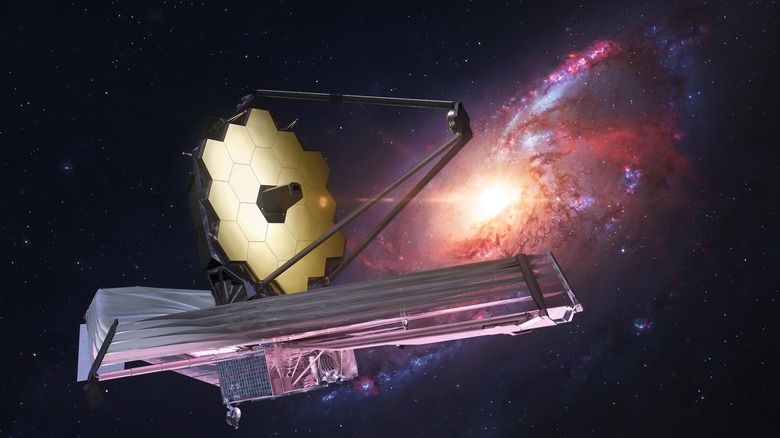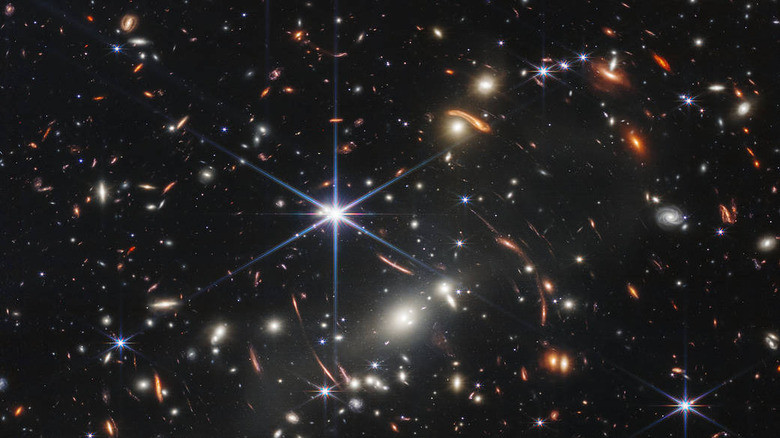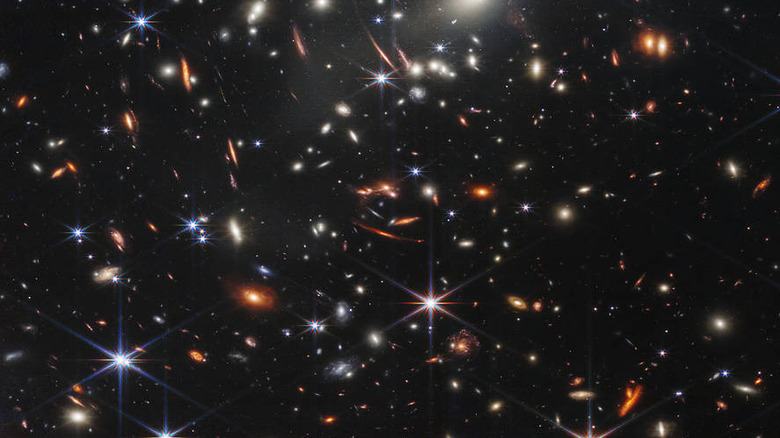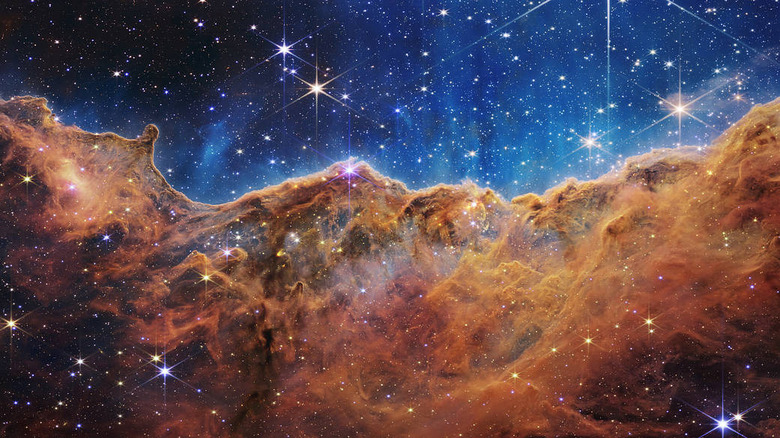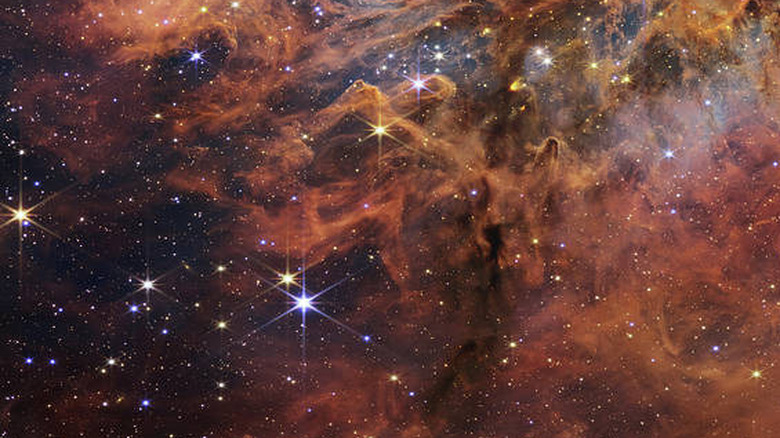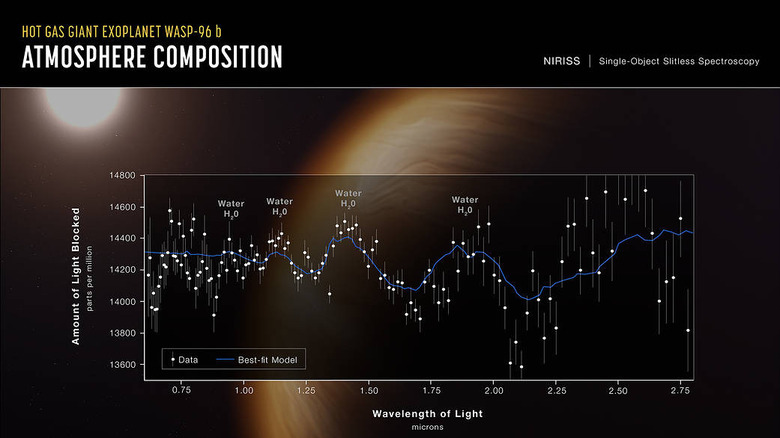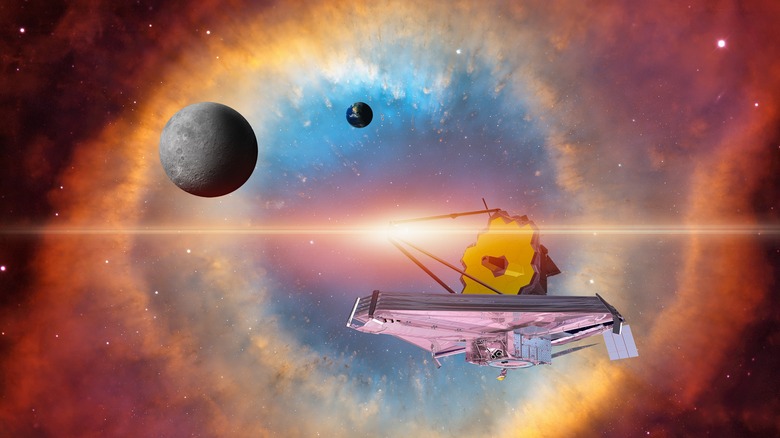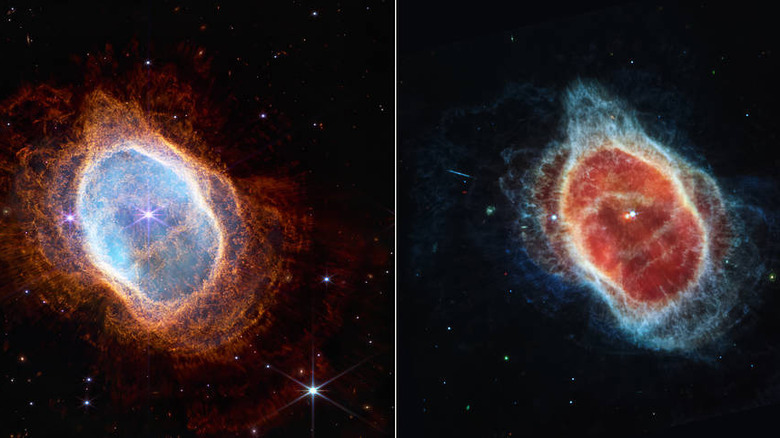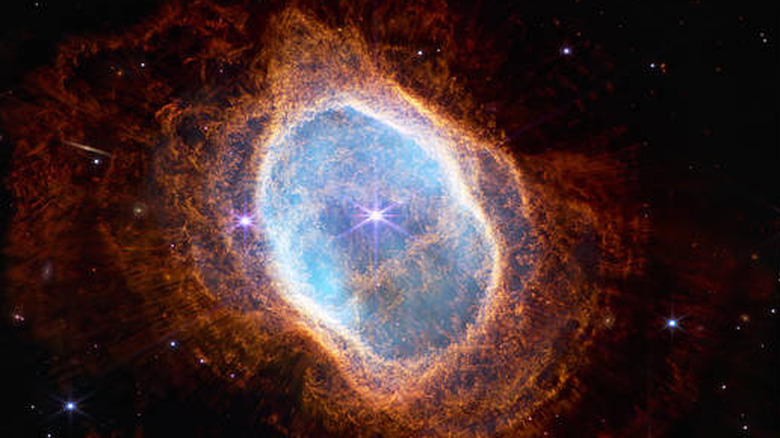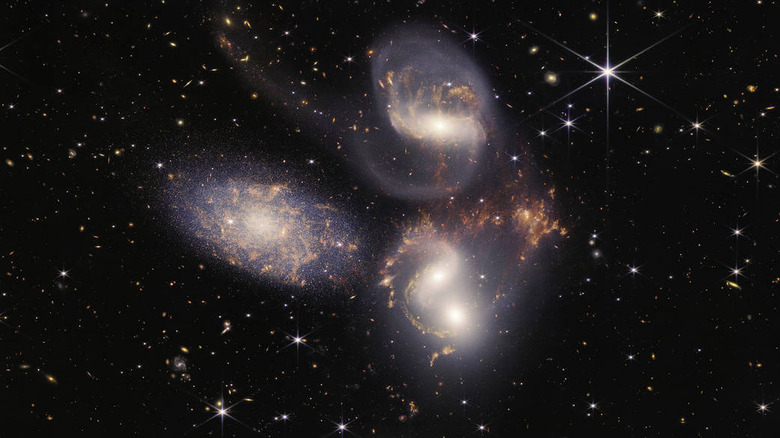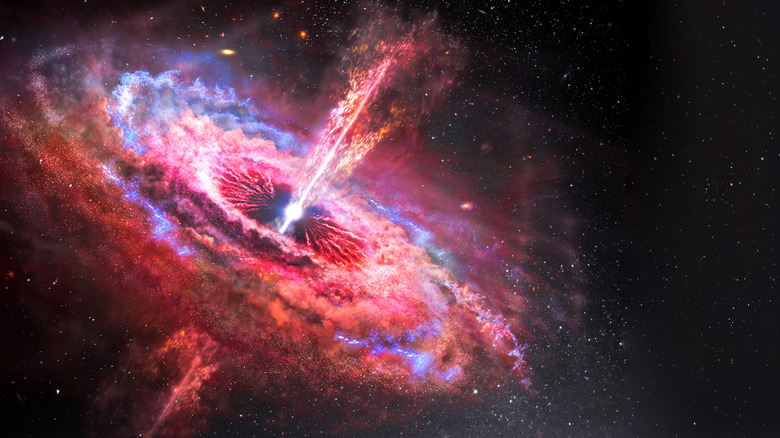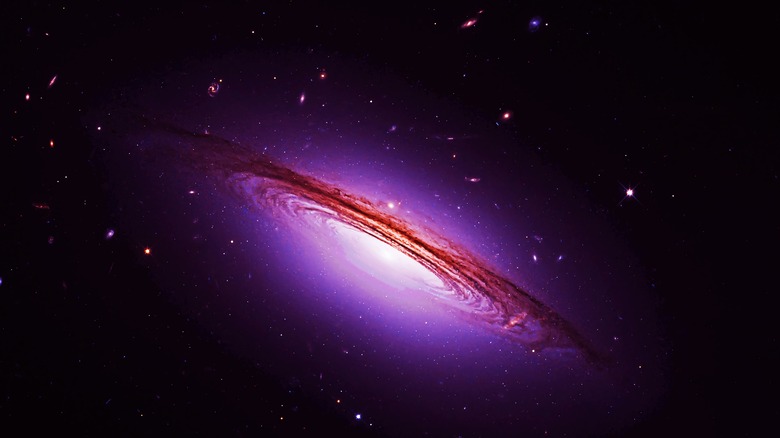What The James Webb Telescope Can Tell Us About Deep Space
When NASA's James Webb Space Telescope was launched, it was expected to beam some incredible images back to Earth. It is now smashing those expectations.
NASA sent Webb into orbit about a million miles away from Earth. From there, it imaged its first targets, from glowing galaxies to mystical nebulas. NASA lists these objects as the SMACS 0723 galaxy cluster, the Carina Nebula, the five galaxies in Stephan's Quintet, the Southern Ring Nebula, and the planet WASP-96 b, which is a searing-hot orb of gas. It proved that it can see not only far out, but far back. It caught glimpses of light that was emitted when the universe wasn't yet a billion years old. In cosmic terms, that is nothing.
"Those are just the first images," Gregory Robinson, Program Director for Webb, told Scientific American. "Think about the many years of images and other things we're going to learn with this telescope about potentially habitable planets. We're going to learn a lot of that over time, not just the first images."
Webb's unprecedented suite of instruments is an upgrade from even the Hubble Space Telescope. Not that Hubble hasn't made momentous discoveries in the past three decades, but Webb is taking that to another level. It can make out light that was too faint for any telescope to have caught in the past and find what had gone undetected. Prepare for liftoff — and for your mind to be blown.
This is what thousands of galaxies looked like 4.6 billion years ago
Ever dreamed of riding a time machine back to the dawn of the universe? When NASA revealed the first Webb image, galaxy cluster SMACS 0723 (which had previously been imaged by Hubble), human eyes had never seen it in such unreal detail before.
You are seeing SMACS 0723 as it was long before any dinosaur even existed. The space agency's website reports that this particular image is looking back in time 4.6 billion years, but Webb picked up on the light of some galaxies that took 13.1 billion years to travel to where the telescope could capture it. Think about it. NASA's most current knowledge of the age of the universe puts it at about 13.8 billion years old. Meaning, Webb has seen light from some galaxies as they were not long — cosmically speaking — after the Big Bang.
Webb's NIRCam (Near-Infrared Camera) and MIRI (Mid-Infrared Instrument) made it possible to create this visual. What you are looking at is not just a snapshot. It is the result of multiple images captured by NIRCam and MIRI in the near-infrared part of the light spectrum, and according to NASA's official NIRCam page, the camera's coronagraphs allow it to detect and image extremely faint objects by blocking out surrounding starlight from brighter objects. MIRI's page details how it merges the capabilities of a powerful camera and a spectrograph to bring such images to light.
Things lurking behind SMACS 0723 are starting to show their faces
No one knows where the universe begins and ends (if it does). There are even more distant galaxies, stars, and who knows what else beyond SMACS 0723, but they might not go unseen for long.
As NASA further explains about SMACS 0723, the enormous combined mass of the thousands of galaxies in this cluster can bring them out of hiding. It creates a gravitational lensing effect — a phenomenon in which larger objects in space distort the light of smaller objects behind them, which magnifies those objects. This allows the telescope to pick up on even more distant galaxies, which NIRCam then brings into focus. Galaxies 13.1 billion light-years away and even farther were showing up in the observations that created this image. While they appear like faint glimpses of light in the background, future observations could tell us about things going on in the early universe that we might have never imagined.
"Over time, as the space-time continuum stretched with the expansion of the universe, the light itself was stretched," Webb scientist Ken Sembach told Scientific American. "As that light has crossed the universe, it's gotten redder and it's been on its way for 13 and a half billion years."
NASA administrator Bill Nelson told PBS that light shoots through space at 186,000 miles per second. He believes Webb could possibly end up seeing "almost to the beginning," as far back as 13.5 billion years ago.
The Carina Nebula's Cosmic Cliffs are exploding with new stars
Space is dusty. That dust often gets in the way of telescope observations, because, as NASA says, visible light has a hard time getting through all that dust because it scatters too easily.
Webb sees in infrared. These longer wavelengths can get past the densely packed molecules in masses of gas and dust like the "Cosmic Cliffs" of the Carina Nebula. Stars being born in the Cliffs, also known as NGC 3324, were previously too faint to be seen behind gaseous, dusty globs that appear when observing in visible light, according to NASA. NIRCam and MIRI allowed the images to be captured.
Another thing Webb will be able to see is how the explosion of star birth in this region influences the mountainous clouds of the nebula. The most immense stars unleash intense stellar winds and bursts of energy that can gnaw away at the dust and gas in the body of a nebula, but scientists are still learning about the impact of younger, smaller, highly energetic stars. There are many more of these stars in the Carina Nebula than their brighter brethren, but previous difficulty seeing them left behind many unknowns 7,600 light-years away.
Webb should eventually be able to demystify how many young stars are hiding in the Cosmic Cliffs and how they affect the evolution of the nebula.
Mystical starscapes will tell us more about star formation
Though many previously unknown aspects of star formation have recently been illuminated, there is still so much in the dark. Webb will be able to pick up on evidence for how stars are born and keep evolving.
The material floating around in a nebula fuels star formation. The Cosmic Cliffs are actually "the edge of the giant, gaseous cavity within NGC 3324," according to NASA. Stellar winds and UV radiation from blazing, massive stars eroded this cavity. As the cavity continues to yawn wider, more stars will emerge from material that collapses. NASA describes star birth as happening when massive clouds of dust begin to collapse in on themselves because they can't handle their own gravity anymore. Protostars begin to form when the core of such a cloud becomes intensely heated. These star embryos are often twins or triplets that come from the same gaseous mass, which is why most star systems have at least two or three stars. (Think Tatooine and its two suns.) Some of the material that they shed as they develop may turn into planets or asteroids.
What we know about stars emerging in the Carina Nebula comes from Hubble observations. As Hubble's official page for this nebula says, new stars are thought to have first burst onto the scene about three million years ago, and it is now going through another wave of star formation within the cavity that is just beyond the Cosmic Cliffs.
There's water on the blazing hot, gaseous planet WASP-96 b
While previous observations had picked up on what were thought to be water molecules in the atmosphere of this hostile planet, Webb has confirmed the presence of water beyond the shadow of a doubt, according to NASA. The telescope was able to see the signature of water in much more detail among the hazy clouds of WASP-96 b. This was pulled off by its NIRISS (Near-Infrared Imager and Slitless Spectrograph) instrument, whose Fine Guidance Sensor (FGS) gives the telescope ultimate precision.
NASA's official NIRISS/FGS page explains how the dual instrument uses FGS to tell the telescope exactly where to turn so it can zero in on its target. NIRISS can then observe in three modes that each see different wavelengths of light. It watched WASP-96 b transit its star for 6.4 hours, as the space agency says. Some starlight was blocked while the planet crawled across space in front of its star. NIRISS came up with a light curve that showed the gradual dimming of light caused by the planet, but it went into even more depth than that.
The telescope beamed back a transmission spectrum that comes from, as NASA reports, "comparing starlight filtered through a planet's atmosphere as it moves across the star, to the unfiltered starlight detected when the planet is beside the star." It gave away the presence of water vapor, clouds, haze along with the levels of atmospheric gases.
WASP-96 b is also revealing what we never knew about its atmosphere
What we knew about WASP 96 b's atmosphere before was, according to Astronomy Magazine, that it is full of sodium and scorching hot. The presence of sodium was thought to mean the planet had cloudless skies, since the element is difficult to detect through clouds. But Webb observed haze and clouds that had, until now, gone unseen.
Webb was able to see what other telescopes could not because, as NASA says, the NIRISS transmission spectrum shows the planet's atmosphere in wavelengths that were not possible to observe with other devices. There is a certain part of the spectrum that is not only sensitive to the water vapor that was found on WASP-96 b, but also to molecules that were not "immediately detectable" in the planet's atmosphere but should be found on other planets Webb will observe. These include oxygen, carbon dioxide, and methane. Webb will soon search the atmospheres and surfaces of more exoplanets. WASP-96 b is a gas giant with no actual surface, but some of those planets might be potentially habitable.
More investigation is on the horizon. For now, the WASP-96 b transmission spectrum is the most detailed ever. NASA sees researchers using it to find out not only what trace amounts of other molecules besides H2O and sodium exist in a planet's atmosphere, but to then use those observations — and whatever else Webb can tell them about a planet's atmosphere — to find out what the planet is made of and where it formed.
Last gasps of a dying star in the Southern Ring Nebula have been captured
Nebulae can be stunning, but there is a grim side to planetary nebulae like the Southern Ring Nebula or NGC 3132, also known as the Eight-Burst Nebula.
NASA explains this Webb observation and reveals that (despite having nothing to do with planets except a vague resemblance to them) planetary nebulae are actually formed by gas and dust belched out by stars in their death throes. Hubble had previously observed NGC 3132, according to its page on the nebula, and caught the two stars inside, one of which was on its last gasp. Gases were found to be escaping the center of the nebula, where the brighter and more alive star burns, at breakneck speed. The second, fading star is smaller than our sun and was too faint for Hubble to make out much else except the unearthly glow of its UV radiation.
Now NASA reports that when it zoomed in, Webb found out the star is shrouded in dust. This star was imaged by NIRCam (left) and MIRI (right). Of the two stars in the binary system within the Southern Ring Nebula, the dimmer one might be releasing most of the gas, but the brighter one really affects what the nebula looks like. Both have some impact — they are orbiting each other and moving dust and gas around in the process — but the doomed one doesn't influence its appearance nearly as much.
Nebula metamorphosis is slowly coming to light
How do nebulae evolve? Planetary nebulae can live for tens of thousands years, according to NASA, and because of this, "observing the nebula is like watching a movie in exceptionally slow motion."
Stars shed layers of gas throughout their lives. Every time another layer is cast off, it affects the makeup of the nebula, with the widest shells on the outside being the oldest, and getting smaller and newer as you move inward. Webb was able to capture many of these. Depending on the shell that is ejected, it might add more or less of a type of molecule to the nebula, and varying levels of gas and dust can act like a time capsule going back to the early days of the nebula.
A study published in Astronomy & Astrophysics found that arcs of material at its extremes partially overlapped emissions from its stars. This could mean that they were formed from gas that was expelled by the stars, especially the one near the end of its life. The Southern Ring Nebula will continue to evolve as its two stars orbit each other, and while planetary nebulae may be not be planets themselves, planets often emerge from nebulae. That stardust might end up in a totally different part of space and still morph into a planet. Another one of Webb's priorities, as detailed in an earlier NASA release, will be to look deep into nascent planetary systems.
How galaxies merge will be seen like never before in Stephan's Quintet
And now for Webb's largest image... Stephan's Quintet. NASA reports that it took a thousand separate image files just to put this visual together.
Webb was able to zoom close enough to see how one galaxy sets off star formation or disturbs gas in another — something scientists don't get to see too often. Webb's images show star clusters and regions of emerging stars that could not be seen by any other telescope before. Because four out of five galaxies in Stephan's Quintet are so close, they inevitably have interactions with one another. Stars, gas, and dust are being shoved around, and galaxy NGC 7318B is seen sending shock waves through the cluster as it barges in. There could be a merger waiting to happen.
There will be massive cosmic drama if two or more of these galaxies do merge. According to Nature, mergers are just part of being a huge galaxy, since most larger galaxies (including our own) have been through at least one. Mergers are also thought to increase star formation. Whenever there weren't as many galaxies joining forces, not as many stars were born. Taking a closer look at galactic mergers could tell us how galaxies collided in the beginning and evolved for billions of years.
Because of all the interactions that happen among its five galaxies, Stephan's Quintet can give better insight on how these processes occur in other galaxies.
Monstrous black holes are getting the cosmic spotlight
Supermassive black holes lurk at the center of every galaxy. In one of the Stephan's Quintet galaxies, NGC 7319, lurks a gargantuan black hole, or active galactic nucleus (AGN). Webb saw through the dust to get the clearest view of it and what it ejects.
The NGC 7319 black hole is, according to NASA, 24 million solar masses. Its ginormous gravitational pull means material is always falling into its gaping maw and then getting violently ejected (which is what puts the "active" in "active galactic nucleus"). Webb got a closeup of it with NIRSpec and MIRI, which captured everything they possibly could, which meant ultra hi-res infrared data. AGNs are surrounded by the dust and gas they devour, as Webb's AGN page says, which is why you need infrared light that can penetrate it. This black hole gorges on whatever gets too close and spews out enough light energy to power 40 billion suns.
Webb will soon have its eye on another supermassive black hole. While this one is not in Stephan's Quintet, measuring its mass could solve some mysteries about the feeding habits of AGNs and what these beasts do to a galaxy. They could possibly affect the galaxies they inhabit with the energetic jets they blast out in either direction, and when galaxies and their supermassive black holes merge, that means the black holes get fed even more material as they creep ever closer to each other.
We might be seeing how black holes formed in the early universe
Many more galactic cliques similar to Stephan's Quintet are believed to have existed when the universe was just yawning awake.
Back then, NASA says, it was possible quasars — massive and outrageously bright active galactic nuclei — formed when extremely hot material collapsed. Existing quasars could also tell us more about what the universe was like right after it was born. The farthest one ever observed is about 13 billion light-years away, according to AAS Nova, so it appears as it did when the universe was barely a billion years old. Supermassive black holes supposedly powered quasars up by eating more and more material. How they could have gotten to be as large as they are is still a mystery, as most quasars observed by scientists don't seem to be growing quickly enough to account for their incredible size.
Another NASA release discusses how Webb will use quasars to find out how the early universe went through its growing pains. Though there are no images of them yet, the quasars Webb is currently peering at could tell us more about how such objects formed and evolved in the young universe, and possibly how they got to be such monsters. Enter NIRSpec. It will gaze at some of the brightest and most distant quasars in the universe with its infrared vision, which will act as a cosmic flashlight to illuminate relics from the beginning of time.
Whatever you might expect from Webb, prepare for it to venture further from your expectations than you ever imagined.
